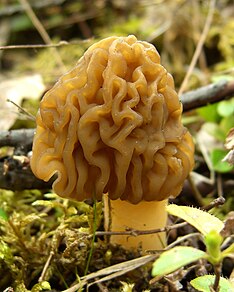Ptychoverpa bohemica
| Verpa bohemica | |
|---|---|
 |
|
| Scientific classification | |
| Kingdom: | Fungi |
| Division: | Ascomycota |
| Class: | Ascomycetes |
| Order: | Pezizales |
| Family: | Morchellaceae |
| Genus: | Verpa |
| Species: | V. bohemica |
| Binomial name | |
|
Verpa bohemica (Krombh.) J.Schröt. (1893) |
|
| Synonyms | |
|
|
| Verpa bohemica | |
|---|---|
| Mycological characteristics | |
| smooth hymenium | |
| cap is convex | |
| hymenium attachment is not applicable | |
| stipe is bare | |
| spore print is yellow | |
| ecology is saprotrophic | |
|
|
edibility: edible or poisonous |
edibility: edible
Verpa bohemica is a species of fungus in the family Morchellaceae. Commonly known as the early morel (or early false morel) or the wrinkled thimble-cap, it is one of several species known informally as a "false morel". The mushroom has a pale yellow or brown thimble-shaped cap—2 to 4 cm (0.8 to 1.6 in) in diameter by 2 to 5 cm (0.8 to 2.0 in) long—that has a surface wrinkled and ribbed with brain-like convolutions. The cap hangs from the top of a lighter-colored, brittle stem that measures up to 12 cm (4.7 in) long by 1 to 2.5 cm (0.4 to 1.0 in) thick. Microscopically, the mushroom is distinguished by its large spores, typically 60–80 by 15–18 µm, and the presence of only two spores per ascus.
In the field, the mushroom is reliably distinguished from the true morels on the basis of cap attachment: V. bohemica has a cap that hangs completely free from the stem. Although widely considered edible, consumption of the mushroom is generally not advised due to reports of poisoning in susceptible individuals. Poisoning symptoms include upset and lack of muscular coordination. V. bohemica is found in northern North America, Europe, and Asia. It fruits in early spring, growing on the ground in woods following the snowmelt, before the appearance of "true morels" (genus Morchella). The synonym Ptychoverpa bohemica is often used by European mycologists.
The species was first described in the scientific literature by the Czech physician and mycologist Julius Vincenz von Krombholz in 1828, under the name Morchella bohemica. The German naturalist Joseph Schröter transferred it to the genus Verpa in 1893.Ptychoverpa bohemica is a synonym that was published by Frenchman Jean Louis Émile Boudier in his 1907 treatise on the Discomycetes of Europe; the name is still occasionally used, especially in European publications. Boudier believed that the large, curved ascospores and the rare and short paraphyses were sufficiently distinct to warrant a new genus to contain the single species.Ptychoverpa has also been classified as a section of Verpa. The section is characterized by the presence of thick longitudinal ridges on the cap that can be simple or forked.
...
Wikipedia
